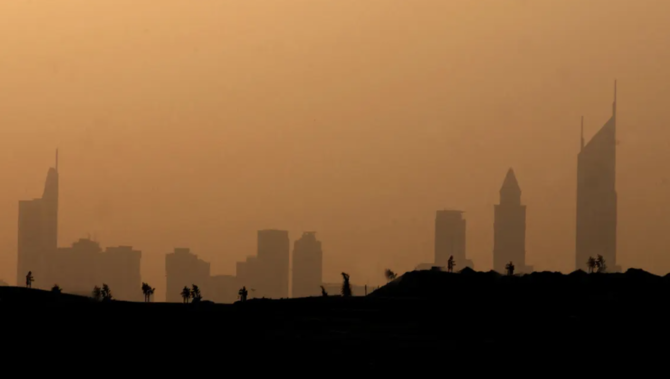
- ARAB NEWS
- 18 Jul 2025

The world experienced a blistering heat wave this summer, with July breaking records as the hottest month ever recorded, according to the World Meteorological Organization and the EU’s Copernicus Climate Change Service. To put into perspective the impact such extreme weather can have on societies, a summer 2022 heat wave claimed the lives of more than 60,000 people in Europe.
The Middle East and North Africa region, already recognized as the most water-stressed in the world, has grappled with extreme heat in recent times and is set to face significantly elevated temperatures by the close of this century. A study published by The Lancet Planetary Health in April predicted that the number of heat-related deaths in the MENA region will rise by 123 per 100,000 people, putting it about 60-fold above the current figure. In the event of sustained high global greenhouse gas emissions, air temperatures in the region may approach 50 degrees Celsius by the end of the century. Nonetheless, if global warming is capped at 2 C above pre-industrial levels, then 80 percent of the forecasted fatalities could be prevented.
Heat waves can have a detrimental effect on individuals and society at large. Primarily, they can have an immediate impact on human health, causing a number of severely uncomfortable illnesses like heat exhaustion, heatstroke, dehydration and fainting. Vulnerable segments of society — such as infants, the elderly, people with low incomes, people with disabilities and people with health conditions — are especially susceptible to heat-related illnesses and deaths.
Moreover, prolonged exposure to extreme heat can exacerbate mental health issues, causing fatigue, sleep disruption, confusion and irritability. Workers who have to operate outdoors — such as delivery drivers, construction workers, farmers and fishermen — are also especially susceptible to the ravages of extreme heat, which can reduce overall labor productivity. Furthermore, hot seasons can put a strain on healthcare facilities, as they receive influxes of patients with heat-related illnesses.
On a larger scale, heat waves can harm local environments in the form of reduced or damaged agricultural yields, water shortages, wildfires and impacts on biodiversity. All of these factors can affect the well-being of communities as they face food and water shortages, price hikes, damage to homes, drought seasons and worsening air quality.
Critical urban infrastructure is also impacted severely as extreme heat tends to damage roads, railway tracks, bridges, dams and power lines. Structural damage to buildings due to extreme heat can increase demand for energy consumption and cooling, which can overload power stations, surge energy bills and further increase greenhouse gas emissions.
Chiefly, it is critical that MENA policymakers are proactive in implementing measures to prepare for and mitigate the impacts of extreme heat, especially as heat waves in the region are becoming more frequent and intense due to climate change. Thus, regional governments need to adopt a multifaceted policy approach that ensures swift collaboration between key stakeholders to protect communities from the adverse effects of extreme heat and build resilience in the face of climate change. Heat action plans are a critical step in managing cities and their populations to navigate seasons of extreme heat with minimal disruption, damage and fatalities.
Regional governments need to adopt a multifaceted policy approach that ensures swift collaboration between key stakeholders.
Sara Al-Mulla
Preparation is key, so it is critical that cities and populations are issued with early warnings regarding heat alerts through various communications channels. This can be achieved by establishing meteorological data systems that track temperature trends, provide timely heat wave alerts and assess the effectiveness of interventions.
Urban planners can mitigate the effects of extreme heat by launching mass tree-planting plans, offering urban tree canopies, building pockets of green space within neighborhoods in cities and incorporating heat-resistant public spaces such as cooling centers. For instance, Saudi Arabia has launched a large-scale afforestation project, with the aim of planting 10 billion trees across the Kingdom to help tackle climate change.
When it comes to sustaining valuable natural resources, such as water and energy, policymakers need to implement stringent water conservation policies and encourage energy-efficient systems. Buildings need to incorporate heat-resistant materials and insulation, in addition to air conditioning, green roofs and green walls. The Singapore Green Building Masterplan, for example, aims to green 80 percent of buildings by 2030 via energy-efficient solutions and mandatory sustainable construction practices.
To mitigate food security concerns, it is important to invest in sustainable farming practices that reduce vulnerability to extreme heat. Investing in sustainable public transportation systems that are resilient to extreme heat is pivotal in providing people with practical modes of mobility during heat waves. It can also reduce reliance on heat-generating vehicles.
Full-fledged health plans need to be devised and deployed effectively in the event of extreme heat waves. Health facilities need to be fully equipped with ample wards, medical equipment, cooling systems and backup power during hot seasons. In this vein, medical workers and emergency responders need to be trained to recognize and treat all heat-related emergencies.
Public health awareness campaigns can communicate crucial information to the public, especially vulnerable populations, about protecting themselves from the risks of extreme heat, the range of heat-related illnesses and common symptoms, the importance of hydration, cooling strategies, how to limit outdoor activities and emergency contacts in case of the need for medical assistance.
At the same time, it is vital that vulnerable groups are protected during heat waves by offering social assistance programs targeting low-income individuals, such as paying for their energy bills. Legislators should also revise regulations regarding safeguarding people with outdoor work, such as mandatory breaks during peak hot hours and the provision of water, food and cooling areas.
The myriad challenges posed by extreme heat necessitate proactive policies to protect the region’s populations from its adverse effects.